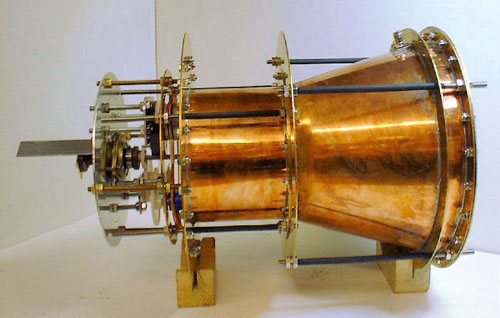Extrapolating from Einstein’s Relativity on the thought experiment of a cylinder with an internal emission of electromagnetic radiation from the left wall to the right wall, electromagnetic energy is emitted from the left narrow end of the EM Drive and travels down the length of the EM Drive “cylinder” to the right wider end, depositing heat (mass). The radiation carries energy, but it also carries momentum and exerts a pressure on the left wall, equal to the energy of the radiation beam. As a result of this emission, the EM Drive receives a push to the left. Thus, the radiation carries momentum and energy. This radiant energy traverses the EM Drive cylinder to the wider end, is absorbed, and ultimately converted into thermal energy. The mass moves when thermal energy changes location.
The recoil from the emission of radiation travels along the sides of the EM Drive cylinder as a vibrational wave with the speed of sound, so that this wave arrives at the right larger end long after the radiation does. Meanwhile, the absorption of the radiation at the wider end causes a second vibrational wave which travels back along the sides of the EM Drive cylinder.
In absorbing the radiation at the larger end, this end's mass increases because the recoil kinetic energy is negligible. Also, interactions in the asymmetric resonant cavity increase the net unbalanced force in the direction of the wider end.

EM Drive
References
Taylor, Edwin F., and Wheeler, John Archibold, Introduction to Special Relativity, ia800503.us.archive.org/22/items/SpacetimePhysicsIntroductionToSpecialRelativityTaylorWheelerPDF/Spacetime%20Physics%20-%20Introduction%20to%20Special%20Relativity%20%5BTaylor-Wheeler%5DPDF.pdf pdf page 266/324, (Book Page 255) Exercise 8.5 first figure, Transfer of Mass by Radiation. Okun, Lev B., Energy and Mass in Relativity Theory, 2009, page 14 https://books.google.com/
Fetta, Guido P., Electromagnetic Thruster, Patent US 20140013724 A1, 2014, Abstract
https://www.google.com/
Copyright © 2025 David William Jedell
Email: d.w.jedell@gmail.com
THE ENTIRE JEDELL REPORT:ALL RIGHTS RESERVED 2025 DAVID WILLIAM JEDELL





No comments:
Post a Comment